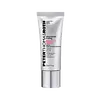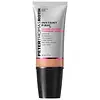What's inside
What's inside
 Key Ingredients
Key Ingredients

 Benefits
Benefits

 Concerns
Concerns

 Ingredients Side-by-side
Ingredients Side-by-side

Water
Skin ConditioningGlycerin
HumectantButylene Glycol
HumectantSodium Silicate
BufferingSodium Magnesium Fluorosilicate
AbrasiveMagnesium Aluminum Silicate
AbsorbentSea Water
HumectantCarrageenan
Pullulan
Sodium Phytate
Xanthan Gum
EmulsifyingHydrolyzed Rhodophyceae Extract
Sodium Benzoate
MaskingFoeniculum Vulgare Seed Extract
Skin ConditioningSymphytum Officinale Root Extract
Skin ConditioningDipeptide-2
Skin ConditioningCitric Acid
BufferingPalmitoyl Tetrapeptide-7
Skin ConditioningBoswellia Serrata Extract
Skin ConditioningCentella Asiatica Extract
CleansingMica
Cosmetic ColorantArgania Spinosa Kernel Extract
Skin ConditioningCamellia Sinensis Leaf Extract
AntimicrobialHesperidin Methyl Chalcone
AntioxidantLactobacillus Ferment Lysate
Skin ConditioningSaccharomyces Lysate
Skin ConditioningHydrolyzed Lupine Protein
Skin ConditioningMedicago Sativa Seed Extract
Skin ConditioningTocopheryl Acetate
AntioxidantAscorbic Acid
AntioxidantPanthenol
Skin ConditioningCarbomer
Emulsion StabilisingSodium Citrate
BufferingChlorhexidine Digluconate
AntimicrobialIron Oxides
Titanium Dioxide
Cosmetic Colorant1,2-Hexanediol
Skin ConditioningCaprylyl Glycol
EmollientSteareth-20
CleansingSodium Cocoyl Glutamate
CleansingPotassium Sorbate
PreservativeHydroxyacetophenone
AntioxidantPhenoxyethanol
PreservativeWater, Glycerin, Butylene Glycol, Sodium Silicate, Sodium Magnesium Fluorosilicate, Magnesium Aluminum Silicate, Sea Water, Carrageenan, Pullulan, Sodium Phytate, Xanthan Gum, Hydrolyzed Rhodophyceae Extract, Sodium Benzoate, Foeniculum Vulgare Seed Extract, Symphytum Officinale Root Extract, Dipeptide-2, Citric Acid, Palmitoyl Tetrapeptide-7, Boswellia Serrata Extract, Centella Asiatica Extract, Mica, Argania Spinosa Kernel Extract, Camellia Sinensis Leaf Extract, Hesperidin Methyl Chalcone, Lactobacillus Ferment Lysate, Saccharomyces Lysate, Hydrolyzed Lupine Protein, Medicago Sativa Seed Extract, Tocopheryl Acetate, Ascorbic Acid, Panthenol, Carbomer, Sodium Citrate, Chlorhexidine Digluconate, Iron Oxides, Titanium Dioxide, 1,2-Hexanediol, Caprylyl Glycol, Steareth-20, Sodium Cocoyl Glutamate, Potassium Sorbate, Hydroxyacetophenone, Phenoxyethanol
Water
Skin ConditioningGlycerin
HumectantButylene Glycol
HumectantIsononyl Isononanoate
EmollientCitrus Aurantium Bergamia Fruit Water
Skin ConditioningDimethicone
EmollientButyrospermum Parkii Butter
Skin ConditioningCaprylic/Capric Triglyceride
MaskingGlyceryl Stearate
EmollientPolyglyceryl-6 Distearate
EmulsifyingCetearyl Alcohol
EmollientSorbitan Stearate
EmulsifyingIsostearyl Alcohol
EmollientMica
Cosmetic ColorantButylene Glycol Cocoate
EmulsifyingBacillus/Soybean Ferment Extract
Skin ConditioningDiamond Powder
AbrasiveNiacinamide
SmoothingSodium Hyaluronate
HumectantSodium Hydroxide
BufferingCitric Acid
BufferingGlutamic Acid
HumectantGlycine
BufferingHistidine
HumectantIsoleucine
Skin ConditioningLeucine
Skin ConditioningLysine
Skin ConditioningPhenylalanine
MaskingAlanine
MaskingArginine
MaskingProline
Skin ConditioningSerine
MaskingThreonine
Tyrosine
MaskingValine
MaskingSodium Phytate
Sodium Lactate
BufferingSilica
AbrasiveEthylcellulose
Potassium Sorbate
PreservativeSodium Benzoate
MaskingHydroxyethylcellulose
Emulsion StabilisingAspartic Acid
MaskingDisodium Phosphate
BufferingPolysorbate 60
EmulsifyingSodium Phosphate
BufferingPolysilicone-11
Titanium Dioxide
Cosmetic ColorantEthylhexylglycerin
Skin ConditioningDimethicone Crosspolymer
Emulsion StabilisingCarbomer
Emulsion StabilisingPolymethylsilsesquioxane
Iron Oxides
Phenoxyethanol
PreservativeWater, Glycerin, Butylene Glycol, Isononyl Isononanoate, Citrus Aurantium Bergamia Fruit Water, Dimethicone, Butyrospermum Parkii Butter, Caprylic/Capric Triglyceride, Glyceryl Stearate, Polyglyceryl-6 Distearate, Cetearyl Alcohol, Sorbitan Stearate, Isostearyl Alcohol, Mica, Butylene Glycol Cocoate, Bacillus/Soybean Ferment Extract, Diamond Powder, Niacinamide, Sodium Hyaluronate, Sodium Hydroxide, Citric Acid, Glutamic Acid, Glycine, Histidine, Isoleucine, Leucine, Lysine, Phenylalanine, Alanine, Arginine, Proline, Serine, Threonine, Tyrosine, Valine, Sodium Phytate, Sodium Lactate, Silica, Ethylcellulose, Potassium Sorbate, Sodium Benzoate, Hydroxyethylcellulose, Aspartic Acid, Disodium Phosphate, Polysorbate 60, Sodium Phosphate, Polysilicone-11, Titanium Dioxide, Ethylhexylglycerin, Dimethicone Crosspolymer, Carbomer, Polymethylsilsesquioxane, Iron Oxides, Phenoxyethanol
Ingredients Explained
These ingredients are found in both products.
Ingredients higher up in an ingredient list are typically present in a larger amount.
Butylene Glycol (or BG) is used within cosmetic products for a few different reasons:
Overall, Butylene Glycol is a safe and well-rounded ingredient that works well with other ingredients.
Though this ingredient works well with most skin types, some people with sensitive skin may experience a reaction such as allergic rashes, closed comedones, or itchiness.
Learn more about Butylene GlycolCarbomer is a polymer of acrylic acid. Its main role is to create a gel consistency.
A high amount of carbomer can cause pilling or balling up of products. Don't worry, most products contain 1% or less of carbomer.
Citric Acid is an alpha hydroxy acid (AHA) naturally found in citrus fruits like oranges, lemons, and limes.
Like other AHAs, citric acid can exfoliate skin by breaking down the bonds that hold dead skin cells together. This helps reveal smoother and brighter skin underneath.
However, this exfoliating effect only happens at high concentrations (20%) which can be hard to find in cosmetic products.
Due to this, citric acid is usually included in small amounts as a pH adjuster. This helps keep products slightly more acidic and compatible with skin's natural pH.
In skincare formulas, citric acid can:
While it can provide some skin benefits, research shows lactic acid and glycolic acid are generally more effective and less irritating exfoliants.
Most citric acid used in skincare today is made by fermenting sugars (usually from molasses). This synthetic version is identical to the natural citrus form but easier to stabilize and use in formulations.
Read more about some other popular AHA's here:
Learn more about Citric AcidGlycerin is already naturally found in your skin. It helps moisturize and protect your skin.
A study from 2016 found glycerin to be more effective as a humectant than AHAs and hyaluronic acid.
As a humectant, it helps the skin stay hydrated by pulling moisture to your skin. The low molecular weight of glycerin allows it to pull moisture into the deeper layers of your skin.
Hydrated skin improves your skin barrier; Your skin barrier helps protect against irritants and bacteria.
Glycerin has also been found to have antimicrobial and antiviral properties. Due to these properties, glycerin is often used in wound and burn treatments.
In cosmetics, glycerin is usually derived from plants such as soybean or palm. However, it can also be sourced from animals, such as tallow or animal fat.
This ingredient is organic, colorless, odorless, and non-toxic.
Glycerin is the name for this ingredient in American English. British English uses Glycerol/Glycerine.
Learn more about GlycerinMica is a naturally occurring mineral used to add shimmer and color in cosmetics. It can also help improve the texture of a product or give it an opaque, white/silver color.
Serecite is the name for very fine but ragged grains of mica.
This ingredient is often coated with metal oxides like titanium dioxide. Trace amounts of heavy metals may be found in mica, but these metals are not harmful in our personal products.
Mica has been used since prehistoric times throughout the world. Ancient Egyptian, Indian, Greek, Roman, Aztec, and Chinese civilizations have used mica.
Learn more about MicaPhenoxyethanol is a preservative that has germicide, antimicrobial, and aromatic properties. Studies show that phenoxyethanol can prevent microbial growth. By itself, it has a scent that is similar to that of a rose.
It's often used in formulations along with Caprylyl Glycol to preserve the shelf life of products.
Potassium Sorbate is a preservative used to prevent yeast and mold in products. It is commonly found in both cosmetic and food products.
This ingredient comes from potassium salt derived from sorbic acid. Sorbic acid is a natural antibiotic and effective against fungus.
Both potassium sorbate and sorbic acid can be found in baked goods, cheeses, dried meats, dried fruit, ice cream, pickles, wine, yogurt, and more.
You'll often find this ingredient used with other preservatives.
Learn more about Potassium SorbateSodium Benzoate is a preservative. It's used in both cosmetic and food products to inhibit the growth of mold and bacteria. It is typically produced synthetically.
Both the US FDA and EU Health Committee have approved the use of sodium benzoate. In the US, levels of 0.1% (of the total product) are allowed.
Sodium benzoate works as a preservative by inhibiting the growth of bacteria inside of cells. It prevents the cell from fermenting a type of sugar using an enzyme called phosphofructokinase.
It is the salt of benzoic acid. Foods containing sodium benzoate include soda, salad dressings, condiments, fruit juices, wines, and snack foods.
Studies for using ascorbic acid and sodium benzoate in cosmetics are lacking, especially in skincare routines with multiple steps.
We always recommend speaking with a professional, such as a dermatologist, if you have any concerns.
Learn more about Sodium BenzoateSodium Phytate is the synthetic salt form of phytic acid. Phytic acid is an antioxidant and can be found in plant seeds.
Sodium Phytate is a chelating agent. Chelating agents help prevent metals from binding to water. This helps stabilize the ingredients and the product.
Titanium dioxide is a mineral UV filter widely used in sunscreens and cosmetics.
It is one of only two UV filters officially classified as “mineral” by regulatory agencies, the other being zinc oxide.
Titanium dioxide provides broad-spectrum protection mostly in the UVB and UVAII range, with some protection in the UVAI range.
While its UVA protection isn’t as strong as zinc oxide’s, the difference is minor.
A common myth is that mineral UV filters reflect UV light. However, modern research shows titanium dioxide absorbs UV radiation like chemical filters (~95% absorption & 5% reflection).
Thanks to its non-irritating nature, titanium dioxide is suitable for sensitive, acne-prone, or redness-prone skin. It is unlikely to cause "eye sting" like other sunscreen ingredients.
A major drawback of this ingredient is its white cast and thick texture. This is why mineral sunscreens often leave a white cast and are less cosmetically elegant than chemical/hybrid sunscreens.
To improve white cast and spreadability, micronized or nano-sized titanium dioxide is often used.
There are ongoing concerns surrounding nano-titanium oxide's impact on marine ecosystems.
There is no conclusive evidence that any form of titanium oxide (or any other sunscreen ingredients) will cause harm to marine ecosystems or coral reefs. The science is still developing but many consumers are keeping a close eye on this issue.
Please note, many destinations have reef-safety sunscreen rules. For instance, the U.S. Virgin Islands advises all visitors to use non-nano mineral sunscreens.
Nano mineral sunscreens once raised safety concerns about absorption into skin.
Extensive research has shown that they do not penetrate healthy or damaged skin; they remain safely on the surface and the top layer of dead skin (stratum corneum).
You'll likely find titanium dioxide bundled with alumina, silica, or dimethicone. These ingredients help make titanium dioxide highly photostable; this prevents it from interacting with other formula components under UV light.
Learn more about Titanium DioxideWater. It's the most common cosmetic ingredient of all. You'll usually see it at the top of ingredient lists, meaning that it makes up the largest part of the product.
So why is it so popular? Water most often acts as a solvent - this means that it helps dissolve other ingredients into the formulation.
You'll also recognize water as that liquid we all need to stay alive. If you see this, drink a glass of water. Stay hydrated!
Learn more about WaterThis ingredient is a combination of red, black, and yellow iron oxide pigments. This combination of colors is usually found in foundation, because it results in a "skin" color.